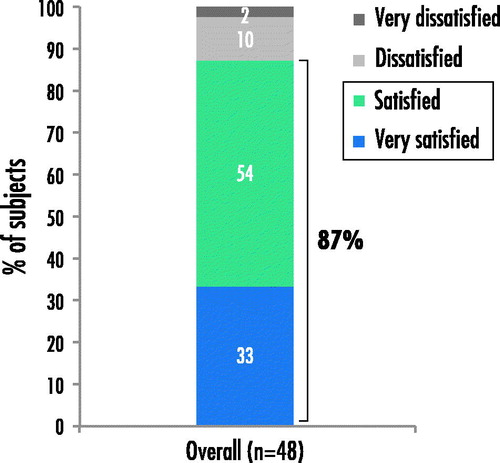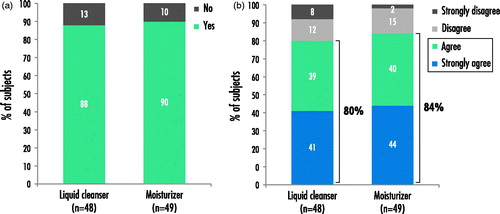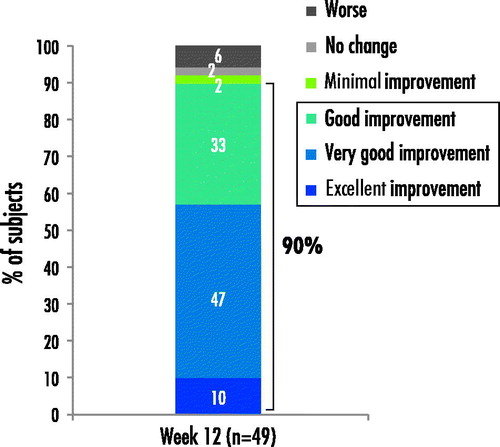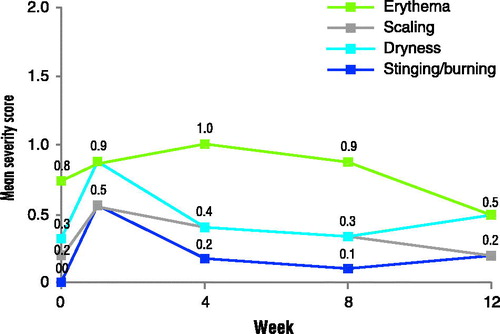Abstract
Background: Skin care products (cleansers and moisturizers) to complement benzoyl peroxide (BPO) in the treatment of acne may improve treatment tolerability and adherence.
Objective: Evaluate subject satisfaction after use of BPO 5% gel in combination with liquid cleanser and moisturizer SPF 30.
Methods: Open-label study including subjects aged ≥12 years with mild-to-moderate facial acne; ClinicalTrials.gov Identifier: NCT02589405. Once daily BPO 5% gel, twice daily liquid cleanser and once daily moisturizer SPF 30 were applied for 12 weeks. Assessments included a subject satisfaction questionnaire, investigator global assessment of improvement, lesion counts, the presence of Propionibacterium acnes, and safety.
Results: Fifty subjects were enrolled. Most subjects were overall satisfied with the three-part regimen (87%) and felt better about themselves (94%). Subjects indicated the skin care products helped prepare the skin for treatment (85%), relieve itchy skin (81%) and reduce irritation (87%). Most subjects considered that the liquid cleanser (80%) and moisturizer SPF 30 (84%) were a necessary part of acne treatment. BPO reduced P. acnes load by 89% at week 1. The treatment was well tolerated.
Conclusions: The combination of BPO 5% gel with liquid cleanser and moisturizer SPF 30 resulted in high levels of subject satisfaction, good tolerability and treatment adherence.
Introduction
Acne vulgaris is a chronic disease affecting approximately 80% of adolescents and young adults [Citation1]. The pathogenesis involves androgen-stimulated increased sebum production, hyperkeratinisation and obstruction of sebaceous follicles. This results in abnormal desquamation of the follicular epithelium and is associated with the bacterial proliferation of Propionibacterium acnes (P. acnes) and chronic inflammation [Citation2,Citation3]. As well as causing scarring and infection, acne can have a profound negative impact on patient quality of life and psychosocial functioning if left untreated [Citation4].
Benzoyl peroxide (BPO) is one of the most effective and safe topical agents for the treatment of acne and has been used for approximately 60 years [Citation1]. BPO is a powerful antimicrobial agent that rapidly reduces P. acnes counts and has the additional advantage of not being associated with bacterial resistance [Citation5]. BPO is effective for mild-to-moderate inflammatory and non-inflammatory acne [Citation6]. However, it can cause skin irritation and may damage the skin barrier, especially during the first weeks of use [Citation1]. Studies have shown that adherence to topical acne treatments is generally poor due to the occurrence of side effects, lack of knowledge about acne and acne treatment and poor patient satisfaction [Citation7,Citation8]. The absence of visible improvement in the initial stages of treatment may discourage patients, leading to poor adherence and consequently reduced efficacy or even therapy failure.
In order to minimize irritation and improve patient adherence to treatment, patients should be given realistic expectations on the type and duration of irritation which are likely to occur before improvement sets in; momentary reduction of the frequency of applications should be proposed in case of bothersome irritation; and proper daily skin care should be recommended as part of the topical treatment regimen from the very beginning of acne treatment. Appropriate skin care products that complement acne therapies are very important in the overall management of acne-prone and acne-affected skin, particularly in order to improve tolerance to BPO and adherence to treatment [Citation9–12]. To avoid over-drying acne skin and worsening any irritation caused by the treatment or by the acne itself, cleansers should be mild in order to wash away excess sebum without altering skin hydration and the skin barrier. Photoprotection is necessary since the alteration of skin barrier integrity by acne and BPO may lead to increased photosensitivity, while non-comedogenic moisturizers can help restore the skin barrier; this can be achieved through the use of a single non-comedogenic moisturizer with an SPF of 30 or higher [Citation13–15]. Studies have demonstrated that moisturizer SPF 30 increases skin hydration, prevents transepidermal water loss and improves the tolerability of a variety of topical acne treatments, such as BPO-containing formulations [Citation9,Citation14,Citation16]. However, few studies have assessed the association of self-care products with acne treatments and there is a lack of information on objective outcomes of tolerance, patient satisfaction, adherence to treatment, and efficacy, as well as the compatibility of such combination regimens.
This study evaluated the combination of topical BPO 5% gel with a mild cleanser (liquid cleanser) and a photoprotective moisturizer (moisturizer SPF 30), as a three-part regimen. The BPO 5% gel formulation (Benzac® Spots treatment gel 5%, Galderma) uses the acrylate copolymer technology to adsorb excess sebum on the skin surface and deliver entrapped glycerin emollient to prolong skin hydration. The liquid cleanser (Benzac® Spots purifying daily facial liquid cleanser, Galderma) was developed specifically to respect facial skin undergoing acne treatment and it has been shown to increase the skin’s overall appearance (95% of panelists), and increase skin softness, moisturizing and brightness (87% of panelists; data on file, Galderma) [Citation17]. The formulation of the non-soap liquid cleanser is emulsion-containing synthetic surfactants, which results in foaming properties; it is enriched with natural humectants derived from calendula, aloe barbadensis, and olive oil. The moisturizer SPF 30 (Benzac® Spots redness relief moisturizer SPF 30, Galderma) used in this study was designed to improve skin hydration in patients with acne-prone skin and contains glycerin, allantoin and ceramide technology to moisturize, soothe and alleviate irritation, as well as sebum absorbers and mattifying ingredients to reduce oiliness. The moisturizer is non-comedogenic and also provides broad-spectrum photoprotection (SPF 30) to protect acne-prone skin from photosensitivity.
The purpose of this open-label, prospective study conducted at a single center in Germany was to evaluate subject satisfaction after the use of BPO 5% gel in combination with the liquid cleanser and the moisturizer SPF 30.
Methods
Study design
This was a Phase 4, open-label, prospective study conducted at a single center in Germany. Subjects aged 12 years or older with mild-to-moderate facial acne based on investigator global assessment (IGA 2 or 3) and meeting other specific eligibility criteria were enrolled in the study.
BPO 5% gel was to be applied topically on the face once daily (in the evening after washing with the cleanser); the face was to be washed with the liquid cleanser twice daily (morning and evening); and the moisturizer SPF 30 was to be applied once daily (in the morning after washing with the cleanser). The three-part regimen was to be applied for 12 weeks and the study included visits at baseline, week 1, 4, 8, and 12.
This study was conducted in accordance with the principles of the Declaration of Helsinki and the International Conference on Harmonization Good Clinical Practices, in compliance with local regulatory requirements. All subjects provided written informed consent prior to study procedures. ClinicalTrials.gov Identifier: NCT02589405.
Assessments
Patient-reported outcomes were assessed using a subject satisfaction questionnaire administered at week 12/early termination regarding the combination treatment regimen. Global assessment of improvement versus baseline was evaluated at week 12, using a scale from 0 (complete improvement) to 6 (worse). Inflammatory and non-inflammatory lesions of the face, excluding the nose, were counted at each study visit. Additionally, photographs (visible and under UV light) were taken at each visit. P. acnes activity was evaluated using image analysis of their orange fluorescence under UV light, based on the number of orange fluorescence pixels.
Tolerance at the application site (erythema, scaling, dryness, stinging/burning) was assessed at each study visit (on a 4-point scale of 0 = none, 1 = mild, 2 = moderate, 3 = severe), and adverse events (AEs) were recorded throughout the study.
Results
Demographics and baseline characteristics
A total of 50 subjects were enrolled in the study. Of these, 46 (92%) completed the study and 4 (8%) discontinued prematurely (3 [6%] for AE and 1 [2%] subject request). The majority of subjects (92%) had skin phototype II–III, and two-thirds were women. Over half of the subjects (58%) were adults, with a mean age of 21.8 years. Nearly three-quarters (74%) of subjects had mild facial acne and the mean duration of acne prior to inclusion was almost 10 years ().
Table 1. Demographics and baseline disease characteristics.
Subject satisfaction
High levels of satisfaction with the clinical and cosmetic aspects of the treatment were reported. The majority of subjects (approximately 87%) were satisfied to very satisfied, including 33% very satisfied (). The vast majority of subjects were only slightly bothered or not bothered at all by side effects (92%), felt better about themselves (94%), and thought that it was easy or very easy to incorporate the treatment regimen in a daily routine (98%). Moreover, 83–85% subjects were satisfied to very satisfied with the effectiveness of the treatment regimen, observed improvement in their skin condition, wanted to continue using the regimen, were satisfied with the time it took to demonstrate the effect and agreed they would recommend this regimen.
Figure 1. Overall satisfaction with the three-part treatment regimen of benzoyl peroxide 5% gel in combination with liquid cleanser and moisturizer SPF 30.

Subjects indicated that the liquid cleanser helped prepare their skin for treatment (85%). Other cosmetic benefits included making the skin feel soft and smooth, and improving appearance (respectively, 67% and 73% of subjects agreed or strongly agreed) (). Similarly, most subjects agreed that the moisturizer SPF 30 provided cosmetic benefits, such as relieving itchy skin and reducing irritation (81% and 87%, respectively) (). Similar proportions of subjects considered that the two products helped them continue with the treatment (88% and 90%, respectively; ) and agreed that they were an essential part of acne treatment (80% and 84%, respectively; ).
Efficacy
The high levels of satisfaction reported by subjects were supported by the clinical results. The three-part treatment regimen demonstrated marked efficacy throughout the study, with approximately 72% reduction of total lesions after 12 weeks of treatment. After only 1 week of treatment, a 20% reduction was reached and by week 4, the total lesion count was reduced by about half (). A similar trend was observed for the inflammatory and non-inflammatory lesion counts (, respectively).
Figure 4. Median percent change from baseline in (a) total, (b) inflammatory and (c) non-inflammatory lesion counts.

The global assessment of improvement by the investigator revealed that 90% of subjects had good, very good or excellent improvement at week 12 ().
The treatment regimen was effective in reducing P. acnes, from week 1 (89% reduction from baseline in orange fluorescence pixels), which was maintained at week 12 (74% reduction) (). Representative photographs of a subject taken under UV light at baseline, week 1, and week 12 illustrate the reduction in fluorescence ().
Safety
A good adherence to each of the three products was observed for all except one subject who discontinued due to reasons unrelated to the study. The mean adherence was very high (95% for BPO 5% gel and 97% for both the liquid cleanser and the moisturizer SPF 30).
A total of 13 subjects (26%) reported AEs during the study. There were five treatment-related AEs in four subjects (8%). All related AEs were dermatological (rash, skin irritation, and exfoliation). The related AEs leading to discontinuation in two subjects were moderate skin irritation and rash; both resolved without sequelae. The majority of AEs were of mild or moderate severity (8% and 16% of subjects, respectively). Skin irritation (stinging/burning, scaling and dryness) mainly occurred during the first week of treatment and was mild in severity (). Erythema was also mild and relatively stable during the treatment ().
Discussion
In this exploratory study to evaluate patient-reported outcomes in terms of satisfaction with a three-part acne regimen combining BPO 5% gel with a liquid cleanser and a photoprotective moisturizer SPF 30, high levels of satisfaction among subjects were reported after 12 weeks of treatment. The vast majority expressed an overall satisfaction with the three-part treatment regimen, and nearly all were only slightly bothered or not bothered by side effects at all. Furthermore, most subjects were satisfied with the liquid cleanser and moisturizer SPF 30, for example, for preparing the skin for treatment, relieving itchy skin and reducing irritation. In addition, the subjects considered that the two skin care products helped them continue treatment and were a necessary part of acne treatment.
Acne can negatively impact the quality of life and psychosocial functioning of patients, illustrating the importance of effective treatments [Citation4]. In these subjects with a long history of acne (approximately 10 years), nearly all subjects reported feeling better about themselves after using the three-part treatment regimen.
Furthermore, the regimen was easily integrated into their daily routine and adherence to treatment was over 95%. This indicates a marked improvement compared with rates of adherence to topical treatment reported in previous large-scale observational and systematic review studies, ranging from 60% to 76% [Citation7,Citation8]. Moreover, poor adherence was shown to be linked to little or no satisfaction in 27% of patients using topical treatment [Citation7].
Apart from the high levels of satisfaction reported, this regimen demonstrated marked efficacy throughout the study, reducing the number of total lesions by half in the first month of treatment and clearing approximately three-quarters of lesions compared with baseline by the end of the study. The global assessment conducted by the investigators at week 12 corroborated these findings with improvement observed in approximately 90% of subjects.
In accordance with the known effects of BPO, the treatment reduced P. acnes activity. As part of patient education, treating physicians could use UV fluorescence image analysis to provide visual evidence demonstrating the rapid onset (as early as week 1) and high efficacy of BPO 5% gel and thus prevent discouragement of patients in the early stages of therapy.
Overall, the treatment regimen had a good safety profile, with few related dermatological AEs and no related SAEs. As anticipated, skin irritation mainly occurred during the first week of treatment. However, it remained mild in severity, which could be due to better skin preparation with the use of liquid cleanser and photoprotective moisturizer SPF 30 in the three-part regimen. Although BPO is generally well tolerated, the integration of these skin care products into a complete acne regimen to mitigate any skin irritation caused by BPO in the early stages of treatment may have contributed to good adherence by avoiding early discouragement.
Conclusions
The combination of BPO 5% gel with liquid cleanser and a photoprotective moisturizer SPF 30 for 12 weeks showed high levels of subject satisfaction reflecting the favorable tolerability, which resulted in very high adherence to treatment and consequently high efficacy. Subjects were overall satisfied with the three-part regimen and considered the liquid cleanser and moisturizer SPF 30 to be a necessary part of acne treatment.
Acknowledgements
The authors thank Sotirios Georgantopoulos, PhD, and Helen Simpson, PhD, of Galderma for medical writing assistance.
Disclosure statement
Ms Kim served as an investigator for Galderma R&D. Mr Kerrouche is a full-time employee of Galderma R&D.
Additional information
Funding
References
- Russell JJ. Topical therapy for acne. Am Fam Physician. 2000;61:357–366.
- Gollnick H, Cunliffe W, Berson D, et al. Management of acne: a report from a Global Alliance to Improve Outcomes in Acne. J Am Acad Dermatol. 2003;49:S1–S37.
- Thiboutot D, Gollnick H, Bettoli V, et al. New insights into the management of acne: an update from the Global Alliance to Improve Outcomes in Acne group. J Am Acad Dermatol. 2009;60:S1–S50.
- Barnes LE, Levender MM, Fleischer AB Jr, Feldman SR. Quality of life measures for acne patients. Dermatol Clin. 2012;30:293–300.
- Tanghetti EA, Popp KF. A current review of topical benzoyl peroxide: new perspectives on formulation and utilization. Dermatol Clin. 2009;27:17–24.
- Del Rosso JQ. What is the role of benzoyl peroxide cleansers in acne management? Do they decrease Propionibacterium acnes counts? Do they reduce acne lesions? J Clin Aesthet Dermatol. 2008;1:48–51.
- Dréno B, Thiboutot D, Gollnick H, et al. Large-scale worldwide observational study of adherence with acne therapy. Int J Dermatol. 2010;49:448–456.
- Snyder S, Crandell I, Davis SA, et al. Medical adherence to acne therapy: a systematic review. Am J Clin Dermatol. 2014;15:87–94.
- Del Rosso JQ. The role of skin care as an integral component in the management of acne vulgaris: Part 1: The importance of cleanser and moisturizer ingredients, design, and product selection. J Clin Aesthet Dermatol. 2013;6:19–27.
- Draelos ZD. The effect of a daily facial cleanser for normal to oily skin on the skin barrier of subjects with acne. Cutis. 2006;78:34–40.
- Veraldi S, Barbareschi M, Micali G, et al. Role of cleansers in the management of acne: results of an Italian survey in 786 patients. J Dermatolog Treat. 2016;27:439–442.
- Levin J. The relationship of proper skin cleansing to pathophysiology, clinical benefits, and the concomitant use of prescription topical therapies in patients with acne vulgaris. Dermatol Clin. 2016;34:133–145.
- Schorr ES, Sidou F, Kerrouche N. Adjunctive use of a facial moisturizer SPF 30 containing ceramide precursor improves tolerability of topical tretinoin 0.05%: a randomized, investigator-blinded, split-face study. J Drugs Dermatol. 2012;11:1104–1107.
- Bowe WP, Kircik LH. The importance of photoprotection and moisturization in treating acne vulgaris. J Drugs Dermatol. 2014;13:s89–s94.
- Zeichner J. Strategies to minimize irritation and potential iatrogenic post-inflammatory pigmentation when treating acne patients with skin of color. J Drug Dermatol. 2011;10:s25–s26.
- Garcia RL, Graeber M. Tolerability and performance of a moisturizer with SPF 30 in acne subjects undergoing treatment. J Am Acad Dermatol. 2014;70:AB11.
- Data on file. A test was realized on the product Soft Sapone Liquido to assess the efficacy of the product Soft Sapone Liquido, in particular the benefits for all types of skin. Benzac skin care soft liquid soap cosmetic file 047-DC-13. Galderma 2013.





